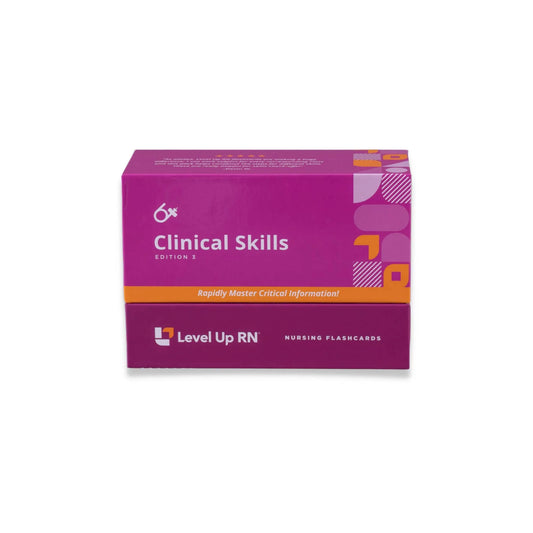When you see this Cool Chicken, that indicates one of Cathy's silly mnemonics to help you remember. The Cool Chicken hints in these articles are just a taste of what's available across our Level Up RN Flashcards for nursing students!
Clinical Skills - Nursing Flashcards
This article demonstrates how to don and doff PPE (personal protective equipment) as part of ensuring infection control when tending to patients.
The Clinical Skills video series follows along with our Clinical Nursing Skills Flashcards, which provide step-by-step instructions and best practices for most skills used by practicing nurses and for the skills tested by most nursing schools during the laboratory portion of fundamentals.
Donning PPE
Donning means to put on. PPE is required when dealing with certain patient situations, for example, when a patient is on isolation precautions.
PPE is always donned in the same order. Some situations do not require certain parts of it, depending on what type of precaution the patient is on. The following is a demonstration of the full order of donning PPE.
1. Perform hand hygiene
Before applying PPE (personal protective equipment) it is important to have already done hand hygiene. This was covered in the previous video in this series.
2. Secure the gown
Starting with the gown, slip the arms in first, find the ties, and tie to secure. Tie the ties in a bow.
For the front ties, tie these around the waist.
3. Don the mask
When putting on a mask, the blue side goes out (if using a medical mask). If there is a metal piece in the nose, bend it so the mask sits snugly on the bridge of the nose. Make sure that the mask is always pulled down to cover the chin.
4. Don eye protection
Next, don eye protection. Note that glasses do not count as eye protection. Additional protection must be worn on top of glasses.
5. Don the gloves
The final step is to don gloves. The gloves need to be pulled down so they go over the cuff of the gown. This way there is no point where any of the hand or wrist or forearm is exposed to anything.
Remember: All of these steps should be taken before entering the patient’s room. If the patient is on any type of precautions, it is important to be safe before entering their space.
Doffing PPE
Doffing means to take off. Remove PPE in the reverse order it was donned.
1. Remove the gloves
Start by taking off the gloves. It is important to remember that these are dirty. You have touched something that is contaminated or been in the room of a patient who is on precautions. That means the gloves are dirty, so care must be taken when removing them.
Pull the first glove off by taking hold of the lower cuff. Do not put fingers of the gloved hand on the inside of the glove to be removed. Slip the first glove off, and roll it up in the palm of the still-gloved hand. Then, with the free hand, slip a finger under the glove and roll that one off. You should have one balled-up glove, with the first glove inside it. Dispose of these.
2. Remove eye protection
To remove eyewear, make sure to touch this piece of equipment as far back as possible. The front is contaminated, having been exposed directly to the patient, so remove eyewear from the back. Once eyewear is removed, either discard it or, as is practiced in many facilities, set the eyewear aside so it can be cleaned and reused.
3. Remove the gown
To remove the gown, untie it first (in practice, often it is easier to simply break the ties).
Remove the arms from the gown by holding the gown by the cuff on the wrist and rolling it down as you slip your arms out. Note that the farthest part of the cuff was protected by the glove cuff, so that’s the safest place to touch the gown.
Once the gown is removed, touch it by the inside (the side that was against you). Then dispose of the gown.
4. Remove the mask
The next step is to remove the mask. As with eye protection, pull the mask off from the back ear loops, not from the front. Pull it straight away from the face, then dispose of the mask.
The reason the mask is doffed last is because PPE has to be removed inside the patient’s room. You can’t leave the patient’s room with any PPE on, or any contaminants that may be in the patient's room will be brought out into the general population. Then, last, remove the mask on the way out the door. That way you are not inhaling anything in the patient’s room that might be infectious.
5. Practice hand hygiene
Always complete the doffing of PPE — after having left the patient's room — with another good hand washing.
Remember: When doffing PPE, avoid touching the outside of the PPE elements, as they have been contaminated.


